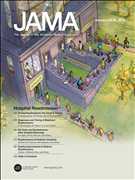JAMA:急诊再就诊率与再住院率持平
2013-01-29 JAMA EGMN
1月23/30日《JAMA》刊载的一份报告显示,成年患者出院后30天内前往急诊科就诊率几乎与再住院率一样高。 美国耶鲁大学Robert Wood Johnson基金会临床学者计划/急诊医学系的Anita A. Vashi博士称,再住院率被视为反映医院诊疗质量的一个指标。出院后的急诊科就诊率也很重要,但过去缺乏相关研究。研究者指出:“如果不考虑急诊的
1月23/30日《JAMA》刊载的一份报告显示,成年患者出院后30天内前往急诊科就诊率几乎与再住院率一样高。
美国耶鲁大学Robert Wood Johnson基金会临床学者计划/急诊医学系的Anita A. Vashi博士称,再住院率被视为反映医院诊疗质量的一个指标。出院后的急诊科就诊率也很重要,但过去缺乏相关研究。研究者指出:“如果不考虑急诊的影响,单纯将再住院率作为评估出院后医疗质量的一个长期指标,可能是不够完整的。”
在这项基于人群的研究中,研究者采用了来自3个地理位置相隔较远的州的数据。最终纳入的样本包括来自加利福尼亚州、佛罗里达州和内布拉斯加州共计5,032,254名出院患者在出院后1年内的数据。这3个州大约占美国每年所有住院人次的17%左右。
所有受试者均为成年人,平均年龄为53.4岁,年龄≥65岁者占29.2%。女性患者略多于半数,白人所占比例接近一半。大部分患者有某些类型的医疗保险。这些患者在接受了470种疾病的住院治疗后出院,内科治疗占65.2%,外科治疗占34.8%。研究者将急诊科就诊仅限于治疗后离院,以排除那些最终导致患者住院的急诊科就诊事件,因为大约有57%的住院病例是从急诊科收治的。
总的来看,共有17.9%的出院患者在出院后30天内至少因急性病前往医院就诊1次。其中1/3左右(35%的急诊科就诊和31%的再住院)发生在出院后7天内。共有7.5%的出院患者出院后至少出现了1次急诊科就诊,另有12.3%至少出现了1次再住院事件。每1,000名出院患者中出现了97.5次急诊科就诊和147.6次再住院事件。
在总共1,233,402人次的出院后急性病就诊事件中,急诊科就诊占到了39.8%(JAMA 2013;309:364-71)。
Vashi博士及其同事指出:“如果只关注再住院事件,会遗漏这3个州将近50万人次的治疗后离开的急诊科就诊事件,从而大大低估内科和外科住院患者出院后的急性病就诊情况。”在医院医疗质量评估中纳入这类急诊科就诊事件十分重要,因其与许多医疗问题密切相关,包括重复服务、诊疗意见冲突、用药失误、患者不满以及成本较高等。
在所有内科出院患者中,消化道疾病(每1,000名出院患者140.7次)和精神病(每1,000名出院患者219.4次)患者出院后30天内的急诊科就诊率最高。心衰患者的急诊科就诊率也比较高。
在所有外科出院患者中,腹腔镜下复杂胆囊切除术(每1,000名出院患者84.5次)和复杂剖宫产术(每1,000名出院患者84.6次)患者的急诊科就诊率最高。PCI伴药物洗脱支架置入术、大型心脏探查术以及复杂髋关节和股骨手术患者出院后的急诊科就诊率也比较高。
在这项研究所涉及的470种疾病中,急诊科就诊率最高的情况是与精神健康相关的问题以及药物和酒精滥用。
Vashi博士及其同事说:“预测患者的需求并且在患者出院之前制定合理的照护计划可能有助于避免其中一些看似不太严重的就诊事件。”例如,“鉴于那些因精神疾病以及药物或酒精滥用而住院的患者出院后的急诊科就诊率特别高,我们应该思考如何在院外为这类患者提供有针对性的急诊诊疗服务”。
研究者提醒道,上述研究结果可能还低估了出院后短期内发生急诊科就诊的出院患者人数,因为没有纳入那些在前往急诊科前就已经死亡、求助于急救中心以及前往“方便门诊”的患者。

Use of Hospital-Based Acute Care Among Patients Recently Discharged From the Hospital
本网站所有内容来源注明为“梅斯医学”或“MedSci原创”的文字、图片和音视频资料,版权均属于梅斯医学所有。非经授权,任何媒体、网站或个人不得转载,授权转载时须注明来源为“梅斯医学”。其它来源的文章系转载文章,或“梅斯号”自媒体发布的文章,仅系出于传递更多信息之目的,本站仅负责审核内容合规,其内容不代表本站立场,本站不负责内容的准确性和版权。如果存在侵权、或不希望被转载的媒体或个人可与我们联系,我们将立即进行删除处理。
在此留言








#再住院率#
31
#就诊率#
30